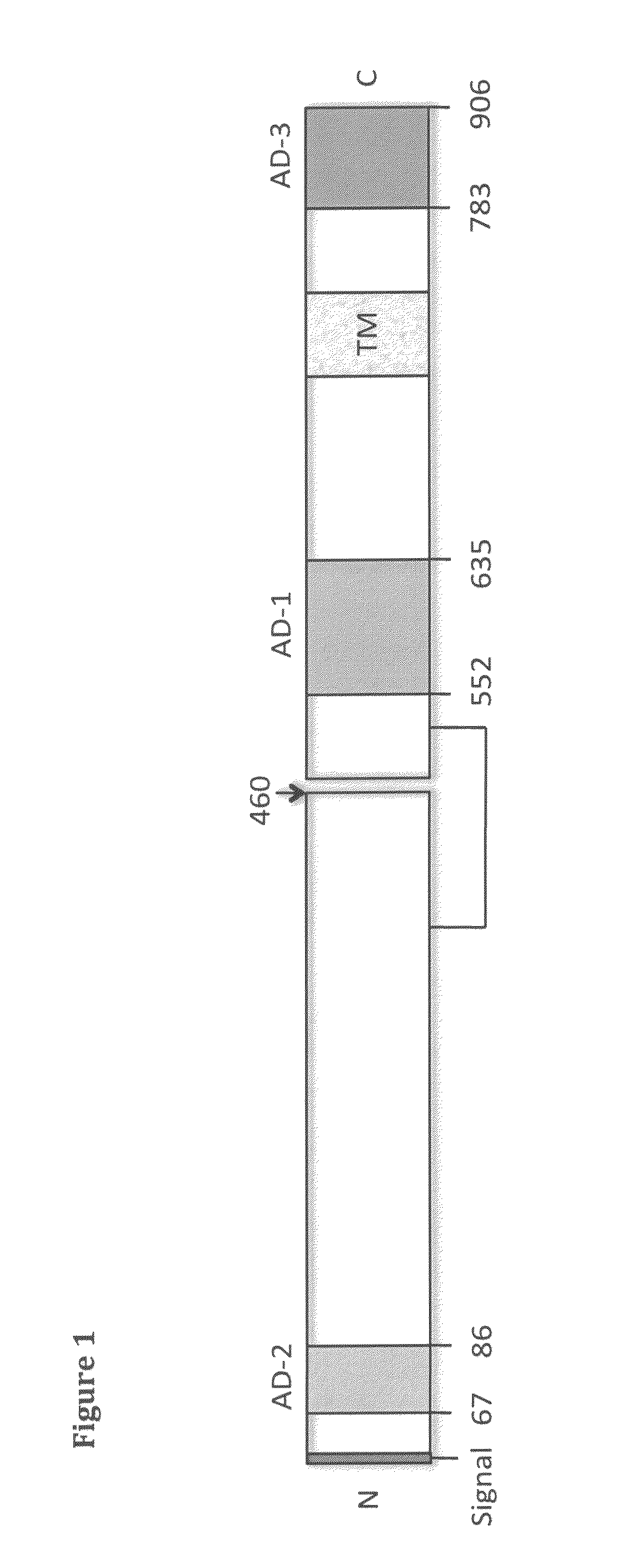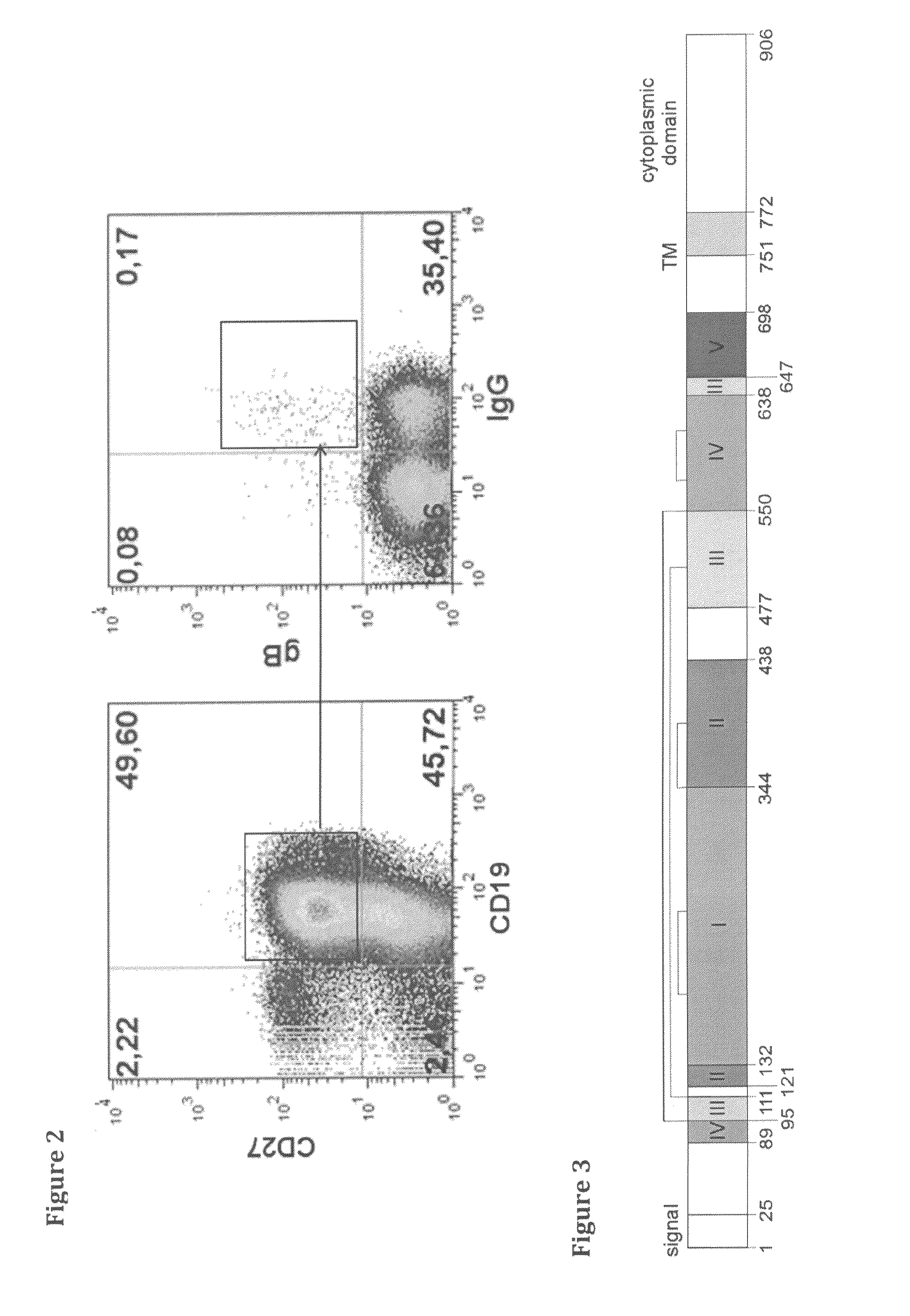Binding members for human cytomegalovirus
a technology of human cytomegalovirus and binding members, which is applied in the field of binding members, can solve the problems of morbidity and mortality, significant economic burden on health care systems, and additional costs of eur 25,000 to 50,000 per patient, and achieves high affinity, high potency, and high potency
- Summary
- Abstract
- Description
- Claims
- Application Information
AI Technical Summary
Problems solved by technology
Method used
Image
Examples
example 1
FACS Sorting of hCMV Specific Memory B Cells and EBV Transformation of IgG-positive Memory B Cells
[0281]After informed donor consent was obtained, peripheral blood (300 ml) was collected from healthy hCMV-seropositive blood donors, whose serum had been pre-screened for high gB-binding titers and efficient hCMV neutralising activity. Peripheral blood mononuclear cells (PBMCs) were purified by Ficoll-density gradient centrifugation (Lymphoflot, Biotest, Dreieich, Germany). After B cell enrichment using anti-human CD22-microbeads (Mitenyi Biotec, Bergisch Gladbach, Germany), B cells were labelled with the following reagents: a. Anti-human CD19-FITC (Miltenyi Biotec, Germany); b. Anti-human CD27-PE (BD Bioscience Pharmigen, Basel, Switzerland); c. anti-human IgG-bio (Jackson Immuno-Research, West Grove, Pa., USA); d. streptavidin, ALEXA FLUOR® 350 conjugate (streptavidin covalently attached to a fluorescent label, Molecular Probes Inc, Eugene, Oreg., USA) and e. Cy5-labeled glycoprotein...
example 2
In vitro hCMV Neutralisation Assay
[0283]The gB-specific culture supernatants were screened for neutralising activity using the hCMV recombinant strain AD169 (HB15-UL84prluc) containing a luciferase reporter gene expression cassette in the hCMV genome, and which results in the expression of luciferase enzyme upon infection of target cells (kindly provided by Prof. Dr. Thomas Stamminger, Institute of Clinical and Molecular Virology, University Hospital Erlangen, Germany). The infectious titer in viral supernatants was determined by TCID50 assays in primary fibroblast cells (either HFF or MRC-5 cells) on 96-well plates as described in Mahy & Kangro (1996). For the luciferase-based neutralisation assay, an equal volume of gB-specific culture supernatant and titered AD169ΔLuc supernatant (300 pfu) were incubated at 37° C. for 1 h in 96 U-bottom microplates. The antibody-virus mixtures were transferred onto previously seeded HFF monolayers. After an additional incubation at 37° C. for 4 h...
example 3
Cloning of Antibody Variable Regions from Anti-hCMV EBV Cell Lines
[0289]In the Examples 3.1 to 3.4 the variable regions of anti-hCMV neutralising antibodies from nine EBV transformed human B cell lines (SM1, 3-7, 9-11) were amplified by semi-nested PCR and cloned in pCDNA3 vectors (Invitrogen) containing the appropriate immunoglobulin constant region. These constructs were subsequently used to transfect CHO cells and the expressed antibodies were tested using suspension array technology and surface plasmon resonance (BIACORE®, (surface plasmon resonance, GE Healthcare) (Example 5) and neutralisation assays (Example 4), for first screenings. In Examples 3.5-3.7, the variable regions of anti-hCMV neutralising antibodies from four EBV transformed human B cell lines (SM10, SM12, 2C2 and 1G2) were amplified by nested PCR and cloned in expression vectors containing the appropriate immunoglobulin constant region according to the method described in Tiller et al., 2008. These constructs wer...
PUM
| Property | Measurement | Unit |
|---|---|---|
| concentration | aaaaa | aaaaa |
| concentration | aaaaa | aaaaa |
| pharmaceutical composition | aaaaa | aaaaa |
Abstract
Description
Claims
Application Information
 Login to View More
Login to View More - R&D
- Intellectual Property
- Life Sciences
- Materials
- Tech Scout
- Unparalleled Data Quality
- Higher Quality Content
- 60% Fewer Hallucinations
Browse by: Latest US Patents, China's latest patents, Technical Efficacy Thesaurus, Application Domain, Technology Topic, Popular Technical Reports.
© 2025 PatSnap. All rights reserved.Legal|Privacy policy|Modern Slavery Act Transparency Statement|Sitemap|About US| Contact US: help@patsnap.com



